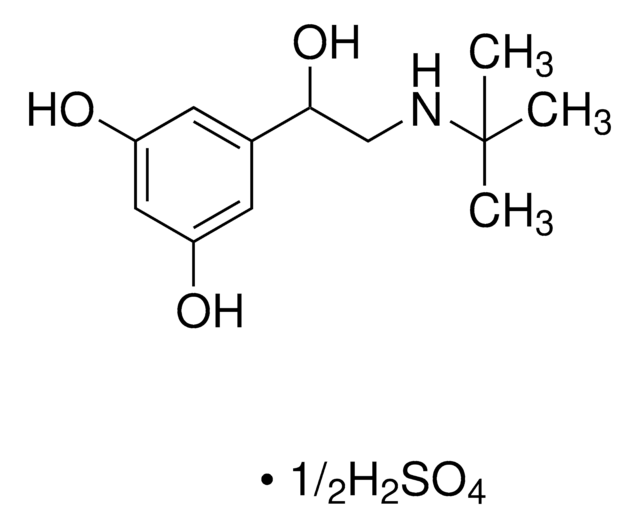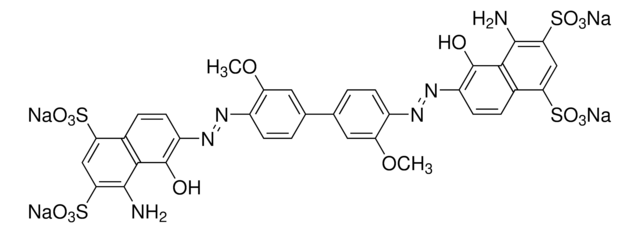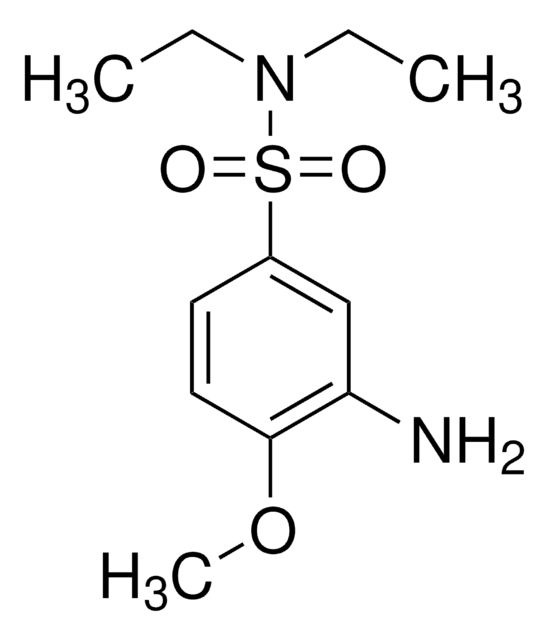T6146
Trypan Blue
powder, BioReagent, suitable for cell culture
Synonym(s):
Direct blue 14, Niagara blue reagent, blue live/dead cell assay
About This Item
Recommended Products
product line
BioReagent
Quality Level
form
powder
composition
Dye content, ~40%
packaging
glass bottle of 100 g
glass bottle of 25 g
glass bottle of 5 g
storage condition
dry at room temperature
technique(s)
cell culture | mammalian: suitable
tissue processing: suitable
mp
>300 °C (lit.)
solubility
H2O: 10 mg/mL
application(s)
cell analysis
SMILES string
[Na+].[Na+].[Na+].[Na+].Cc1cc(ccc1N=Nc2c(O)c3c(N)cc(cc3cc2S([O-])(=O)=O)S([O-])(=O)=O)-c4ccc(N=Nc5c(O)c6c(N)cc(cc6cc5S([O-])(=O)=O)S([O-])(=O)=O)c(C)c4
InChI
1S/C34H28N6O14S4.4Na/c1-15-7-17(3-5-25(15)37-39-31-27(57(49,50)51)11-19-9-21(55(43,44)45)13-23(35)29(19)33(31)41)18-4-6-26(16(2)8-18)38-40-32-28(58(52,53)54)12-20-10-22(56(46,47)48)14-24(36)30(20)34(32)42;;;;/h3-14,41-42H,35-36H2,1-2H3,(H,43,44,45)(H,46,47,48)(H,49,50,51)(H,52,53,54);;;;/q;4*+1/p-4
InChI key
GLNADSQYFUSGOU-UHFFFAOYSA-J
Gene Information
human ... PTPN1(5770) , PTPRF(5792)
Looking for similar products? Visit Product Comparison Guide
General description
Application
- in cell viability assay
- to stain plant tissue in order to to visualize cell death
Biochem/physiol Actions
Preparation Note
Signal Word
Danger
Hazard Statements
Precautionary Statements
Hazard Classifications
Carc. 1B
Storage Class Code
6.1C - Combustible acute toxic Cat.3 / toxic compounds or compounds which causing chronic effects
WGK
WGK 3
Personal Protective Equipment
Regulatory Listings
Regulatory Listings are mainly provided for chemical products. Only limited information can be provided here for non-chemical products. No entry means none of the components are listed. It is the user’s obligation to ensure the safe and legal use of the product.
EU REACH Annex XVII (Restriction List)
Choose from one of the most recent versions:
Already Own This Product?
Find documentation for the products that you have recently purchased in the Document Library.
Customers Also Viewed
Articles
Cell based assays for cell proliferation (BrdU, MTT, WST1), cell viability and cytotoxicity experiments for applications in cancer, neuroscience and stem cell research.
Protocols
The 96 Well 3D Spheroid BME Cell Invasion Assay utilizes 3D Culture Qualified 96 Well Spheroid Formation Plate alongside a specialized Spheroid Formation ECM to drive aggregation and/or spheroid formation of cells.
The 3-D Spheroid Fluorometric Proliferation/Viability Assay offers a high content format for inducing tumor spheroid formation and quantitating cell viability within the spheroids using resazurin fluorescent detection.
Related Content
Three-dimensional (3D) printing of biological tissue is rapidly becoming an integral part of tissue engineering.
Our team of scientists has experience in all areas of research including Life Science, Material Science, Chemical Synthesis, Chromatography, Analytical and many others.
Contact Technical Service









